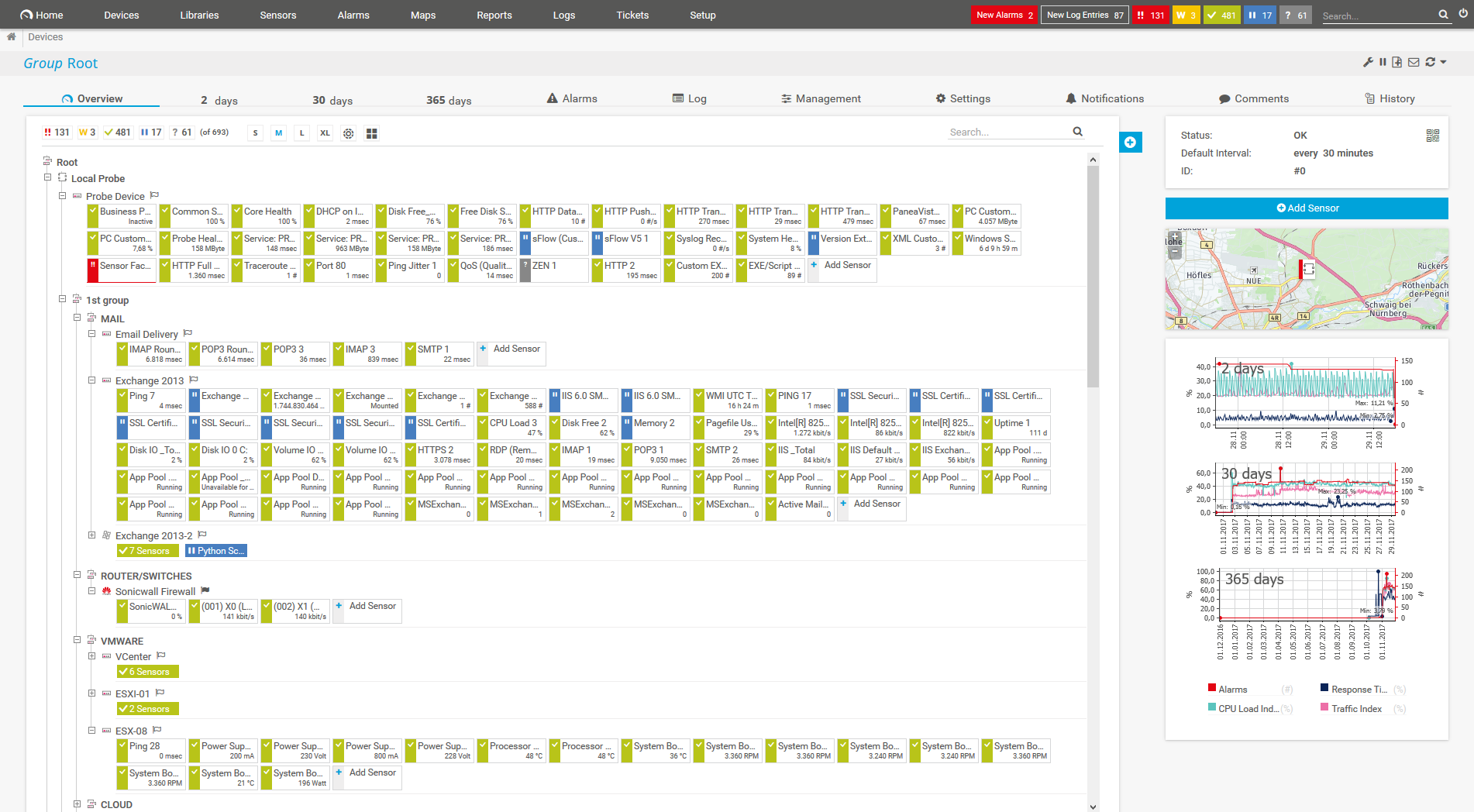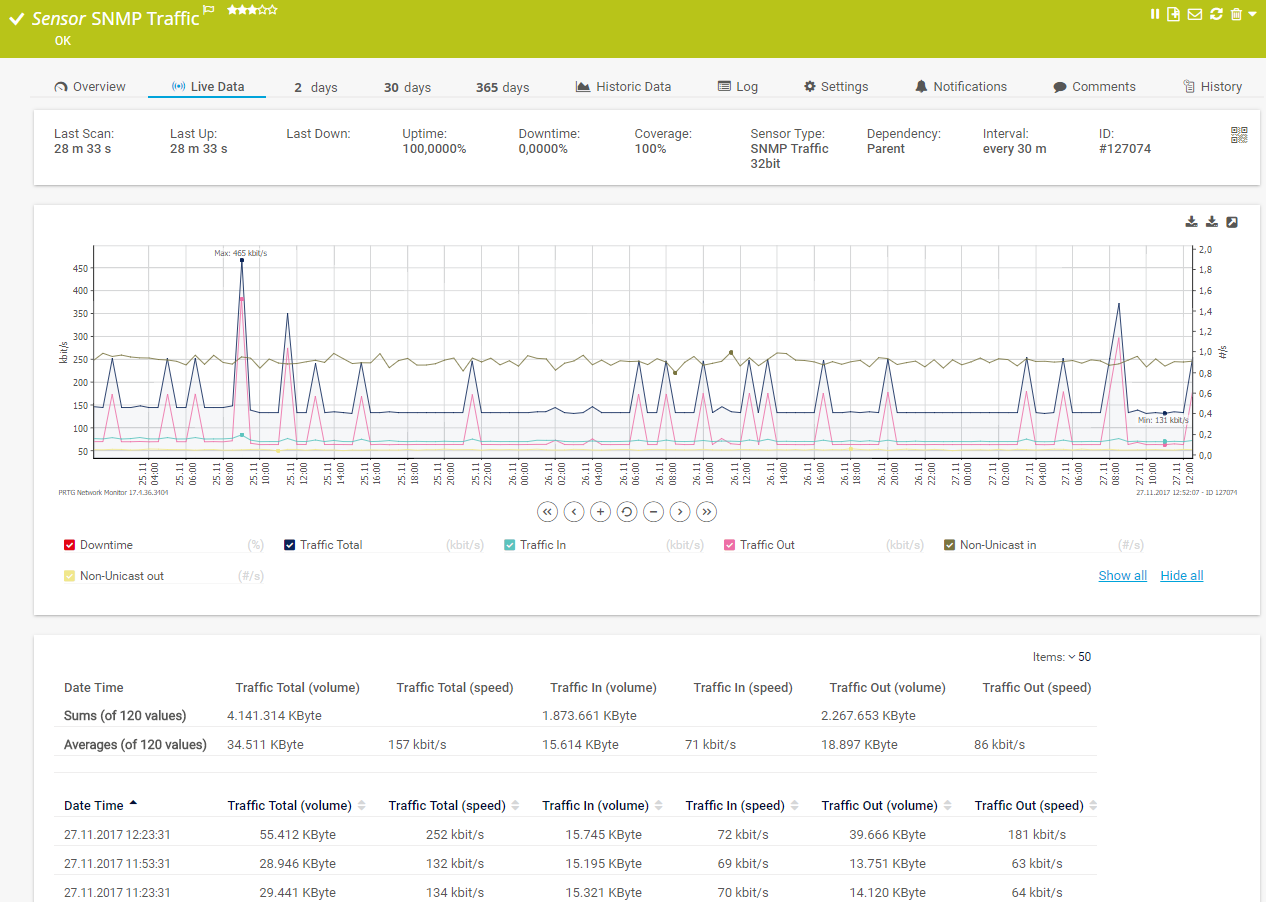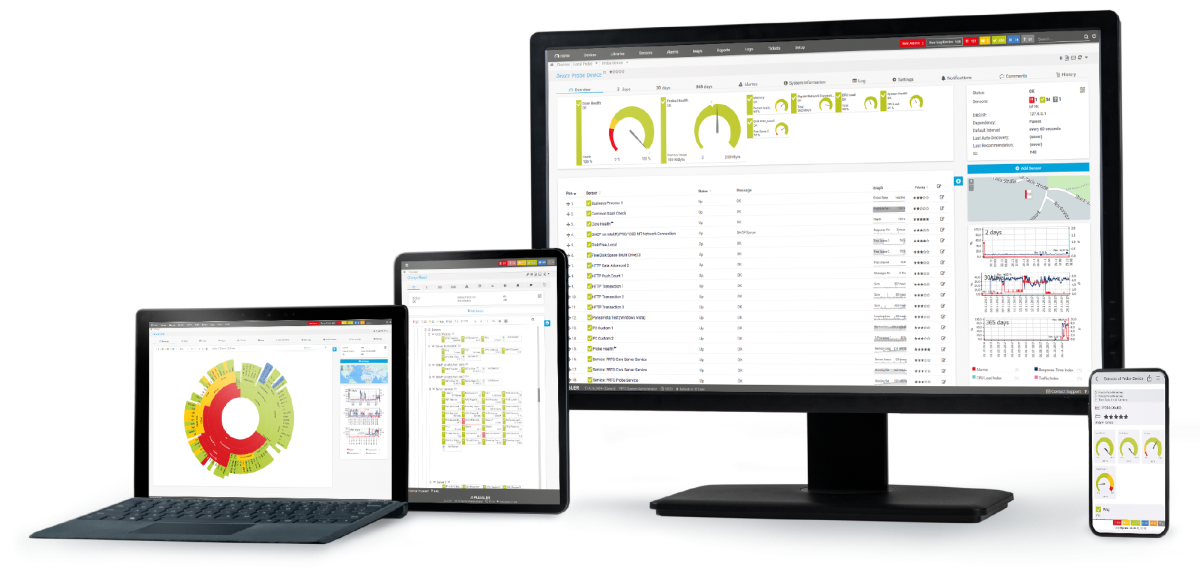Custom alerts and data visualization let you quickly identify and prevent high CPU loads and processor temperatures, cooling system failures, and other causes of overheating.
CPU core temperatures fluctuate. That's normal.
It's when they start spiking regularly that they can cause serious issues. Making your network less stable, inflating your organization's utility bills (cue grumpy accountants calling you to complain), and, worst of all, potentially becoming a fire risk.
With Paessler PRTG, it won't have to come to that.
Our more than 250 preconfigured sensor types watch your computer's CPU temperature, other environmental values, and key network health and performance benchmarks, enabling you to run a more efficient IT infrastructure, extend your hardware's lifespan, and keep your components cool.
If you can't stand the heat… turn it down. But to do this, you first need to know that it’s getting hot. PRTG keeps an eye on the temperature readings of your CPUs, hard drives, servers, as well as your entire server room 24/7, giving you the peace of mind to know that everything’s just fine.
PRTG's interface feels instantly familiar. That's by design. We've worked hard on functionality so you can get up and running and find your way around our dashboard in no time. But you also have the option to tailor your monitoring program exactly the way you want it.
Pick your parameters and let PRTG do the work. Once you've set your preferred CPU temperature limits and other system monitoring thresholds, you'll get alerted via SMS, email, or push notification (with our smart apps for iOS or Android) when a device is at risk of breaching them, so you can fix the issues pronto.
It's not just for tracking CPU temperatures. PRTG also keeps an eye on humidity levels, voltage, CPU usage, fan speed, the availability and status of your power supplies, and much more. Keep your infrastructure stable and secure (and your colleagues and higher-ups happy) with a fraction of the effort.
Diagnose network issues by continuously monitoring the current and maximum temperature of CPUs, routers, switches, and other hardware components. Show system workloads, CPU cooler status, memory usage, and other key metrics in real time and visualize data in graphic maps & dashboards to identify problems more easily. Gain the visibility you need to troubleshoot the causes of overheating.

Device tree view of the complete monitoring setup

Custom PRTG dashboard for keeping an eye on the entire IT infrastructure

Live traffic data graph in PRTG
PRTG comes with more than 250 native sensor types for monitoring your entire on-premises, cloud, and hybrid cloud environment out of the box. Check out some examples below!
See the PRTG Manual for a list of all available sensor types.
Custom alerts and data visualization let you quickly identify and prevent high CPU loads and processor temperatures, cooling system failures, and other causes of overheating.
PRTG is set up in a matter of minutes and can be used on a wide variety of mobile devices.


Hewlett Packard Enterprises and Paessler are collaborating in a fresh new way to bring increased value to you as our customer.
What does this mean for you?
Partnering with innovative IT vendors, Paessler unleashes synergies to create
new and additional benefits for joined customers.
baramundi and PRTG create a secure, reliable and powerful IT infrastructure where you have everything under control - from the traffic in your firewall to the configuration of your clients.
With the combination of PRTG and Insys, the monitoring specialist Paessler and the industrial gateway manufacturer INSYS icom offer a practical possibility to merge IT and OT.
Siemon and Paessler bring together intelligent building technology and advanced monitoring and make your vision of intelligent buildings and data centers become reality.
Real-time notifications mean faster troubleshooting so that you can act before more serious issues occur.
Network Monitoring Software – Version 25.3.110.1313 (August 27, 2025)
Download for Windows and cloud-based version PRTG Hosted Monitor available
English, German, Spanish, French, Portuguese, Dutch, Russian, Japanese, and Simplified Chinese
Network devices, bandwidth, servers, applications, virtual environments, remote systems, IoT, and more
Choose the PRTG Network Monitor subscription that's best for you
A CPU (Central Processing Unit) is the primary component of a computer responsible for interpreting and executing most of the commands from the computer's hardware and software. Often referred to as the "brain" of the computer, the CPU performs the essential operations that allow the computer to function. The CPU is a chip that sits in a specific socket on the motherboard, often beneath a heat sink or fan to manage the heat it generates.
Architecture of the CPU:
Clock Speed: Measured in gigahertz (GHz), it indicates how many cycles per second the CPU can execute, with higher clock speeds typically meaning faster processing.
Cores: Modern CPUs often have multiple cores, which are individual processing units within the CPU. Multi-core CPUs can handle multiple tasks simultaneously, improving performance.
Threads: A thread is a sequence of programmed instructions that the CPU can execute. CPUs with multiple threads can perform multiple tasks more efficiently by managing them concurrently.
Examples of CPUs:
Intel Core i7: A popular CPU series for desktops and laptops, known for high performance.
AMD Ryzen 5: Another widely used CPU series offering strong multi-core performance.
Apple M1: A CPU designed by Apple, used in its Mac computers and known for its efficiency and power.
CPUs overheat for all sorts of reasons. The most obvious causes are poor air flow, high ambient temperatures, and cooling system malfunctions. But technical issues such as resource-heavy processes, outdated firmware, and poorly optimized hardware or software can also cause overheating by making the CPU operate inefficiently or work too hard.
A CPU is too hot if its temperature is higher than the maximum specified by the manufacturer. The limit varies depending on the make and model, but it's typically somewhere between 60°C to 90°C (if you're in the US, that's 140°F to 194°F). If a CPU goes over this limit for any sustained period of time, it can cause network disruptions and become a fire hazard. The device will also be less reliable and have a shorter lifespan.
Because it makes it easier to spot and address the causes of overheating – including those that might not be immediately obvious – before your device becomes unstable or, worse, dangerous. Alongside CPU temperature, PRTG also monitors other key variables that might damage your hardware and make your network less safe and reliable, such as humidity levels and the status of power distribution units and uninterruptible power supplies.
No temperature data? No problem. You can get around it by monitoring other key stats that might impact performance and cause your device to overheat. PRTG has sensors for every variable imaginable, including application performance, CPU load, memory, email, website, and even CCTV monitoring.
The PRTG core server runs on Microsoft Windows (Windows Server 2022, Windows Server 2019, Windows Server 2016, Windows 11, or Windows 10 are recommended). With the help of our built-in multi-platform probe, you can also run PRTG on Linux and other Unix-based systems.
In PRTG, “sensors” are the basic monitoring elements. One sensor usually monitors one measured value in your network, for example the traffic of a switch port, the CPU load of a server, or the free space on a disk drive. On average, you need about 5-10 sensors per device or one sensor per switch port.
Paessler conducted trials in over 600 IT departments worldwide to tune its network monitoring software closer to the needs of sysadmins. The result of the survey: over 95% of the participants would recommend PRTG – or already have.
Paessler PRTG is used by companies of all sizes. Sysadmins love PRTG because it makes their job a whole lot easier.
Bandwidth, servers, virtual environments, websites, VoIP services – PRTG keeps an eye on your entire network.
Everyone has different monitoring needs. That’s why we let you try PRTG for free.